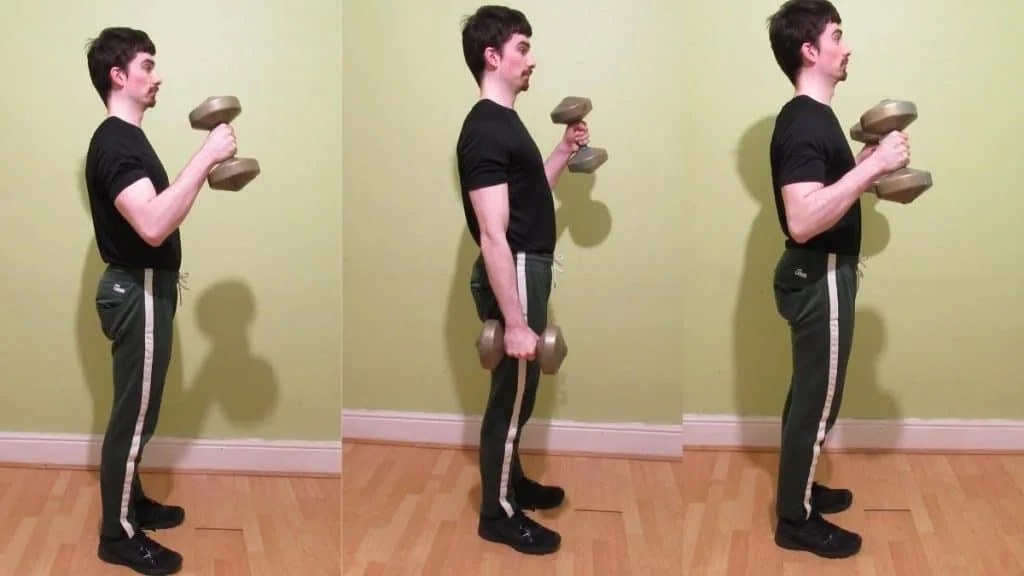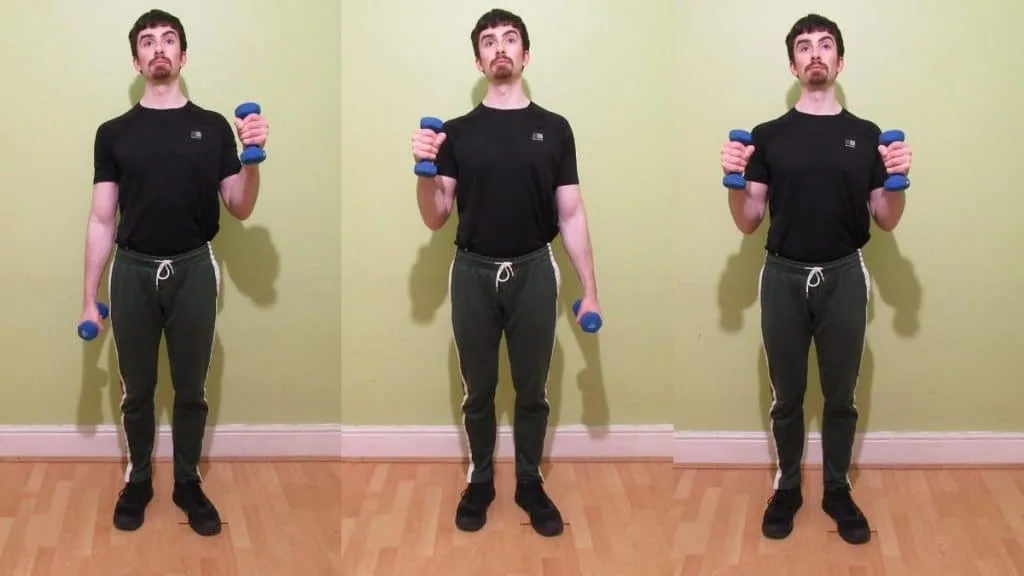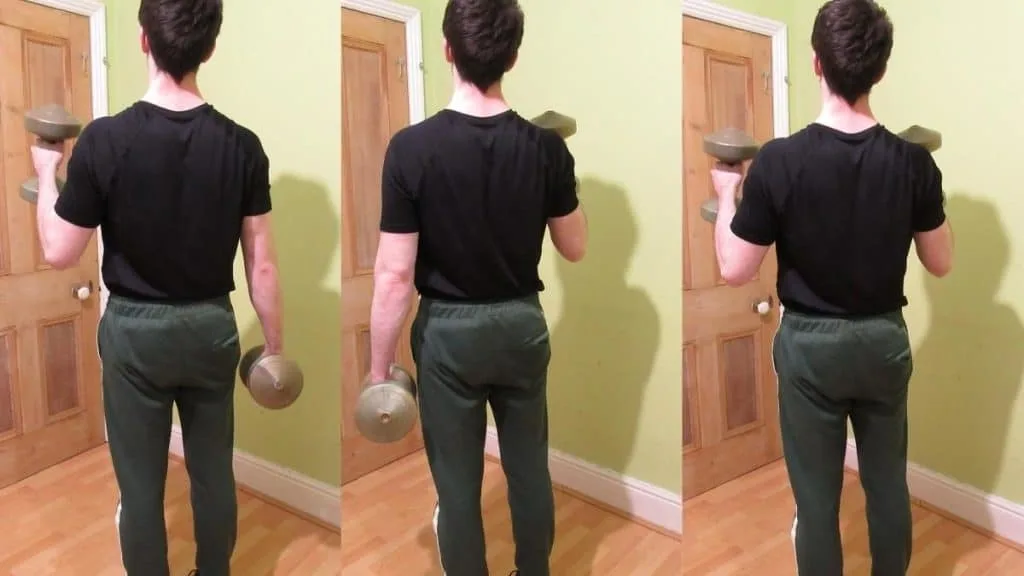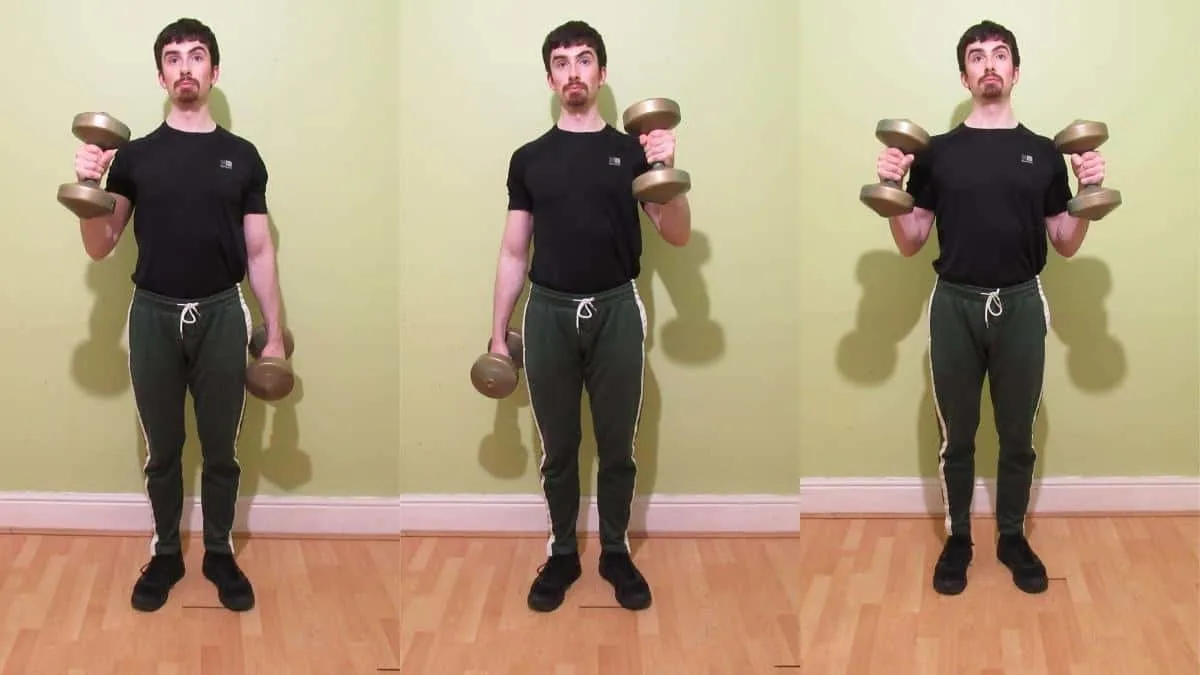We’ve spoken many times about the biceps brachii origin and insertion and, in particular, the fact that you need to train this two-headed muscle from different angles to achieve optimal development.
The standing hammer curl is an excellent exercise in this regard because it works your brachialis and brachioradialis in addition to your biceps. So on a per rep and per set basis, you’re getting much more bang for your buck than you are with regular bicep curls.
But if you want to take the muscle stimulation to an even higher level, then you can do the 1 1 2 hammer curl. This challenging bicep-builder puts your arms through an intense workout every time by forcing you to complete double the number of reps on each set. This extra training volume, in turn, leads to more time under tension and, with enough consistency on your part, more muscle growth as well.
1 1 2 hammer curl exercise details
- Main Muscles: Biceps brachii, brachialis, brachioradialis
- Secondary Muscles: Forearm flexors, forearm extensors
- Exercise Type: Strength
- Exercise Mechanics: Isolation
- Difficulty Level: Intermediate
- Equipment Needed: Dumbbells
How to perform 1 1 2 hammer curls
- Hold a pair of dumbbells by your sides with a neutral grip.
- Curl one of the weights toward your shoulder until your biceps and forearms make forceful contact.
- Lower the weight under control, and repeat the motion with your other arm.
- Next, curl both dumbbells toward their respective shoulders.
- Hold the contraction as you squeeze your biceps, and then lower the weights until your elbows are extended. This is one full rep.
- Perform 3-4 sets of 8-10 complete reps in total.
1 1 2 hammer curl training tips
The 1 1 2 hammer curl is an intense arm exercise. So in order to get the most from the movement and make all that lactic acid worthwhile, it’s recommended to follow these muscle-building training tips.
Use a full range of motion

Because the 1 1 2 hammer curl really blasts your biceps, it can be tempting to choose the path of least resistance to make the inevitable lactic acid burn more tolerable. In practice, this usually entails shortcutting the lifting motion so that your biceps and brachioradialis don’t have to do as much work.
However, from a muscle growth perspective, performing half reps is sub-optimal because it leads to a reduction in muscle fiber recruitment.
Instead, make sure to get a full contraction on every rep. Squeeze your biceps and forearms together, and then lower the weights under control until your elbows are extended.
The reason we want to achieve full elbow extension is so that our triceps are contracted. When the triceps are fully shortened (i.e., contracted), then the biceps are by definition fully lengthened and stretched, which ultimately leads to a more potent muscle growth stimulus. [1]
Start light

With 1, 1, 2 hammer curls, you’re essentially doing twice the number of reps per set as you would on regular hammer curls. As such, you need to use less weight so that your arms can cope with the extra training volume.
You don’t need to neglect progressive overload completely—you can still increase the resistance as you naturally become stronger. Nonetheless, this particular exercise, due to its inherently high time under tension, is more about metabolite accumulation (which leads to the pump) rather than lifting the heaviest weights possible. [2]
So by combining heavy curls with lighter 1, 1, 2 hammer curls, you’re actually getting the best of both worlds by implementing high and low rep training into your program.
See Also: TRX hammer curls
Alternate the order

With the 112 hammer curl, one arm is always going to be performing two reps in a row, while the other receives a few seconds of rest. As such, the arm performing the successive repetitions will likely fatigue before the other.
So to ensure that both of your arms are receiving equal work, vary up the first arm that you curl with on a per set, session, or training cycle basis.
Moreover, if you have noticeable muscle imbalances, then you may actually want to skip this exercise entirely and do some resistance band hammer curls or something similar instead.
The reason being is that, even if you vary up the arm that initiates the set, there’s still a small chance that you might worsen your existing muscle imbalances. So if having optimal muscle symmetry is important for you, then it’s recommended to perform exercises where it’s easy to verify that both arms are receiving the same amount of attention.
Lift explosively

The biceps and brachioradialis muscles are fast-twitch. This means that, first and foremost, they have a larger growth potential than slow-twitch muscles. But it also means that they respond best to fast tempos and explosive contractions. So no slow negatives on this one—you’re getting enough time under tension anyway by performing the 1 1 2 sequence.
The brachialis, on the other hand, which is the small and round muscle that lies beneath the biceps, is predominantly slow-twitch. This means that it grows best from high reps and plenty of training volume.
In this regard, you could argue that 1 1 2 hammer curls are actually the ultimate bicep-builder because, by lifting explosively, you’re training all three muscles close to optimally. On the one hand, you’re getting the powerful contraction for your biceps and brachioradialis, and on the other, you’re also giving your fatigue-resistant brachialis plenty of time under tension.
Now that’s what I call recipe for success.
Should you do 1 1 2 hammer curls or the regular version?

Overall, the 1 1 2 hammer curl is an intense yet effective exercise for building the biceps, brachialis, and brachioradialis muscles. It’s a great way to sneak in more training volume without performing any additional sets—and without having to endure the never-ending workouts that high volume training invariably results in.
Since you’re doing twice the number of reps per set as on regular hammer curls, you can stimulate more muscle growth while spending only a modest amount of extra time in the gym.
For this reason, your best bet is to stick to moderate reps (8-10). And by reps, I mean completes sequences of a 1 1 2 hammer curl. This way, you’re still getting doubler the volume, but without venturing over into endurance training territory.
References
- Antagonistic muscle pairs – Muscular system – Edexcel – GCSE Physical Education Revision – Edexcel. (2021). BBC Bitesize. https://www.bbc.co.uk/bitesize/guides/zpkr82p/revision/4
- de Freitas, M. C., Gerosa-Neto, J., Zanchi, N. E., Lira, F. S., & Rossi, F. E. (2017). Role of metabolic stress for enhancing muscle adaptations: Practical applications. World Journal of Methodology, 7(2), 46. https://doi.org/10.5662/wjm.v7.i2.46

